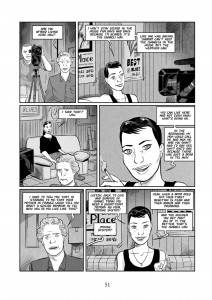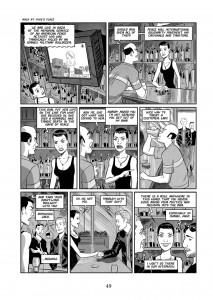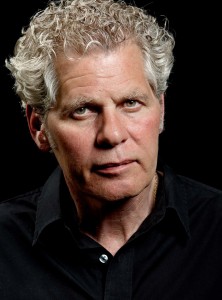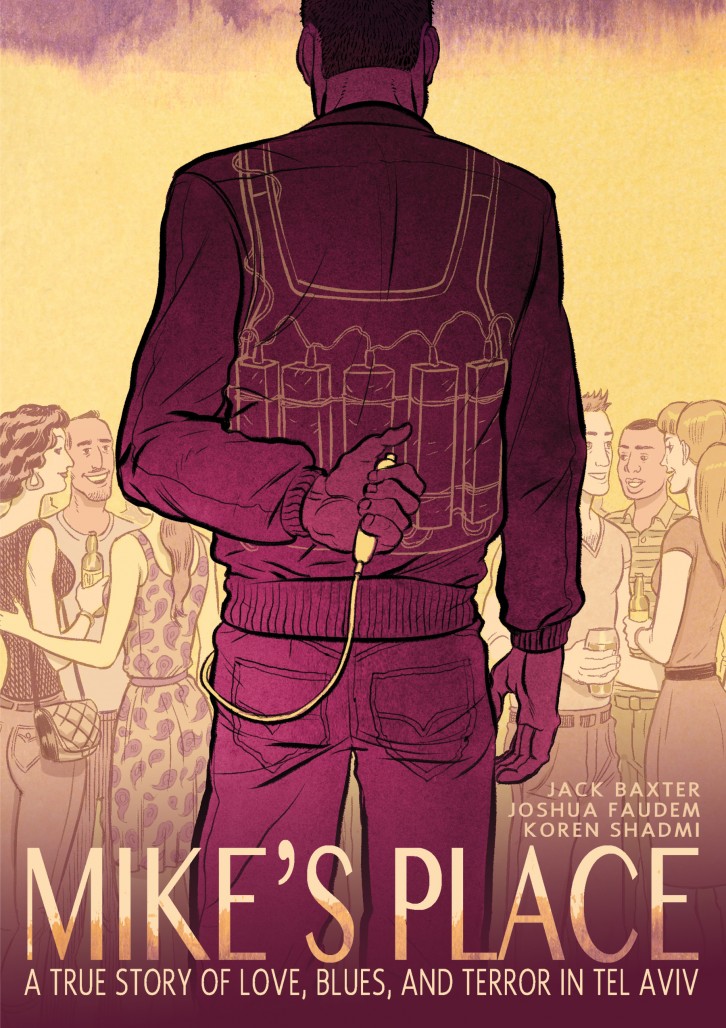By Cal Cleary
Jack Baxter, an American filmmaker, went to Israel in 2003 to make a documentary. When his initial subject fell through, he found a new story in the form of Mike’s Place, a Tel Aviv blues bar where people from all over could meet in peace amidst all the turmoil. There, he met Joshua Faudem, an American-Israeli filmmaker, and the two teamed up to tell the story of Mike’s Place, unaware that the bar would soon be targeted by suicide bombers. They kept the cameras rolling through the aftermath of the bombing and the bar’s rebirth, and Blues By the Beach, their documentary, came out in 2004. Baxter’s newest project finds him re-teaming with Faudem and working with cartoonist Koren Shadmi to dig deeper into both the bombing and the lives of the men and women who frequented the bar. We recently got a chance to speak with Baxter about Mike’s Place, the transition from filmmaking to making graphic novels, and much more.
You come from a history of documentary filmmaking. In addition to producing Blues By the Beach, the making of which you detail here, you also wrote, produced and directed Brother Minister: The Assassination of Malcolm X. What was it about the graphic novel format that interested you as an alternative to filmmaking or a more traditional book?
A graphic novel is essentially the same as a movie storyboard: A continuous storyline with written dialogue and description and illustrations in both mediums.
Actually, in 2006, literary agent Jerry Rudes did pitch a nonfiction book idea to major publishers that I was supposed to write. Long story, didn’t happen. I kept thinking about slogging away on my great American novel for years and years rehashing a tale of woe. I’m glad that book never happened.
Filmmaking is a hassle from day one to the finish line. But the satisfaction quotient from watching a live audience experience something you helped create makes all the work worth it. So when my co-writer and the director of Blues, Joshua Faudem, said we should write a movie screenplay I was all-in. MIKE’S PLACE was born of the screenplay.
Was it challenging to write a graphic novel script, or did the experience you had from crafting narrative out of documentary footage translate easily to the new format?
 We already had a fully realized screenplay filled with description, dialogue, locations, and a fast-paced narrative. When it served the story we used actual scenes and outtakes from Blues by the Beach. First Second provided us with their graphic novel format template, and we re-worked some scenes and dialogue where it was suggested. Once it passed the collective smell test, we were off to the races.
We already had a fully realized screenplay filled with description, dialogue, locations, and a fast-paced narrative. When it served the story we used actual scenes and outtakes from Blues by the Beach. First Second provided us with their graphic novel format template, and we re-worked some scenes and dialogue where it was suggested. Once it passed the collective smell test, we were off to the races.
In terms of storytelling, did you find the graphic novel medium better than film or vice versa?
Creating a graphic novel and making a film are in the same ballpark for me. The big advantage of film is SOUND. The advantage of the graphic novel is that you ingest at your own pace so you can really focus and ruminate. No wonder to me Hollywood is snatching-up this storytelling format left and right. It’s not a giant leap from paper to film. You have built-in visuals that weary-eyed studio readers can more easily rate and recommend.
Blues By the Beach was released very soon after the suicide bombing. With Mike’s Place, you have the added perspective that comes with more than a decade’s distance. Has that changed the way you see the bar, its mission, or the bombing itself?
The mission of Mike’s Place remains the same today as every bar and live-music venue anywhere in the world – social interaction and making a buck. The terrorist conspiracy that tried to send a message to a Tel Aviv beachfront bar, next-door to the American Embassy, failed. Yes, they killed and wounded people, but they didn’t get the “last word” in Israel or here in the USA.
Mike’s Place is bigger than ever and has locations all over Israel and is soon expanding into Europe, and who knows, maybe even another Mike’s Place in a hipster neighborhood in Brooklyn.
Do you see Blues by the Beach and Mike’s Place as companion pieces, or separate works with separate goals?
I think they both stand on their own. The big difference is, in the graphic novel, we were able to dig deeper into our characters, chart the journey and reveal the true motivation of the terrorists. It shows the historical significance of why Mike’s Place was chosen for attack after midnight on April 30, 2003.
Mike’s Place strays so thoroughly from the way we typically see this region. In a lot of ways, the bar at the center of this story wouldn’t feel out-of-place anywhere in the U.S., something you mention being important in the book. Do you think that the way the media portrays this conflict has helped desensitize or dissuade people from believing a lasting peace can be achieved?
There are lots of voices crying in the wilderness. If you don’t like Fox, MSNBC or CNN – change the channel and  check out Al Jazeera and the BBC every once in a while. Meet some Palestinians and Israelis face to face. They don’t have horns on their heads.
check out Al Jazeera and the BBC every once in a while. Meet some Palestinians and Israelis face to face. They don’t have horns on their heads.
If Mike’s Place can serve as an example of a modern Middle East then we’re on to something. And if you go there and you don’t drink, you can always get some falafel or a cheeseburger and listen to free live music. Just make sure no matter what, that you tip the bartenders and waitresses and when the musicians pass the hat, don’t pretend your texting on your iPhone. Now that could really start a war…
What made you choose First Second as the publisher for Mike’s Place?
First Second publisher-editor Mark Siegel is a family friend of the Faudem Family from Michigan. Matter-of-fact, I met Mark’s mother and father at the 2004 Cannes Film Festival eight years before I met him. Joshua suggested I drop off our screenplay and Blues DVD to him at his office, a couple blocks from here. A year later, after Mark finished his own Sailor Twain graphic novel, he saw the film and read the screenplay.
As I see it, all these connections and stars aligning is Bashert – that’s Yiddish for Fate.
How did you meet artist Koren Shadmi?
Through Mark Siegel. He told us he’d always wanted to hire Koren and our project was perfect for him. And when we saw his work, we wanted him too.
Autobiographical and journalistic graphic novels are big right now, and getting bigger every year. Are there any that particularly inspired you?
Hands down, Zahra’s Paradise by Amir & Khalil about the 2009 Iranian elections and Arne Bellstorf’s Baby’s in Black about Astrid Kirchherr and Stuart Sutcliffe and the Beatles in early 1960s Hamburg.
Although much of the story is shown from your perspective, there are a lot of bits that you weren’t present for. Did you go back and talk to any of the Mike’s Place family to fill in those gaps? What kind of research did you do to piece together the parts from the bombers’ perspectives?
 I went back to Israel for two months in March of 2006 for more medical treatments. I interviewed every person I could who was at Mike’s Place that night. Back then I still thought I’d write my great American novel. I compiled everything as part of my research for that prospective book. One survivor, who I was next to that night, “Sugar Shiri” Mirvis, showed me where we were and where security guard Avi Tabib had landed inside the bar.
I went back to Israel for two months in March of 2006 for more medical treatments. I interviewed every person I could who was at Mike’s Place that night. Back then I still thought I’d write my great American novel. I compiled everything as part of my research for that prospective book. One survivor, who I was next to that night, “Sugar Shiri” Mirvis, showed me where we were and where security guard Avi Tabib had landed inside the bar.
I read everything I could about the British terrorists Asif Hanif and Omar Khan Sharif – their seemingly happy boyhood in England, their radicalization and friendship with Mohammad Sidique Khan – the future mastermind of the July 7, 2005 London Transit Attack. And I studied detailed timelines published online by Israeli and British investigators. I think we have a good handle on who they were and what they believed.
http://en.wikipedia.org/wiki/Mohammad_Sidique_Khan
In the book, you come across as incredibly optimistic, as though all it would take for peace in the Middle East is for everyone to just listen to one another for a moment. Would you still consider yourself optimistic about the situation? Are there any hopeful signs you see for the region?
I really come off that naive?
Besides Friedrich Nietzsche, Arthur Schopenhauer is my favorite philosopher. I’ve read both volumes of his The World As Will And Representation. And Schopenhauer’s the patron saint of pessimists.
Forgive me for being a wiseass. It’s getting late here.
I do hope for a lasting peace in the Middle East. But pragmatism urges me to caution. In the present, I try and see past stereotypes. But people and situations are often typecast for good reasons. Like I said to Gal Ganzman when I first met him tending bar at Mike’s Place: “It’s not easy trying to solve the Middle East Conflict.”
As someone who is clearly familiar with this struggle, are there any books or documentaries on the Israeli-Palestinian conflict that you’d recommend to readers who enjoyed Mike’s Place and want to learn more?
For books: Samuel P. Huntington’s The Clash of Civilizations and the T.E. Lawrence masterpiece The Seven Pillars of Wisdom. A great movie comedic tragedy is Palestinian director Elia Suleiman’s Divine Intervention. For documentaries: the brilliant Israeli documentary filmmaker Ram Loevey’s Close, Closed, Closure. And of course, check out Blues by the Beach.
Do you have any upcoming projects, either in film or in graphic novel, planned right now?
Israeli producer Avi Bohbot, director Joshua Faudem and I want to make a documentary about a friend of mine, Imam Benjamin Bilal, who was my Islamic Consultant for Brother Minister and also helped choose the Quran verses showcased in MIKE’S PLACE. Long story short, Ben is a charismatic Muslim-American leader on the rise. He was born a Black Israelite and raised Jewish in Harlem. At thirteen he joined the Nation of Islam, eventually becoming a traditional Muslim. We want to show Ben Bilal in action at his mosque in Trenton, New Jersey, and follow him preaching around North America and Europe. We all wind up in Jerusalem where Islam, Christianity and Judaism meet.
My hope is Ben comes across incredibly optimistic.
IMAM BENJAMIN BILAL May 15, 2015: http://muslimjournal.net/?p=1720
BILAL Trailer: https://vimeo.com/98628538
Mike’s Place is on sale from First Second as of June 9th and can be purchased at your local book retailer.
Be sure to check out the trailer for Mike’s Place : http://www.mikesplacebook.com/
http://www.youtube.com/watch?v=nxFzZGm4nuk



